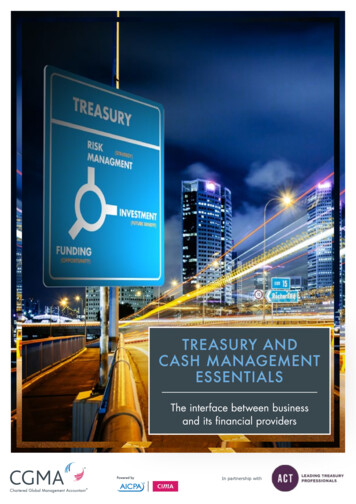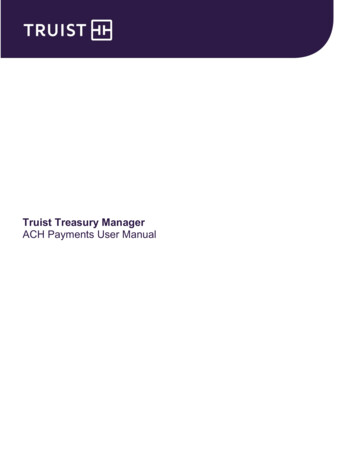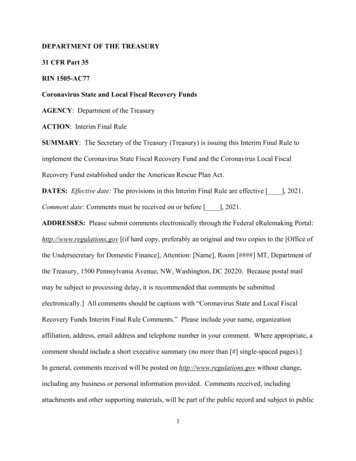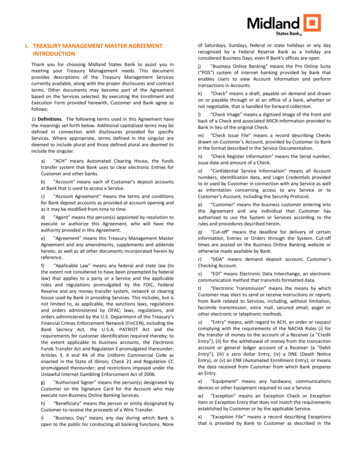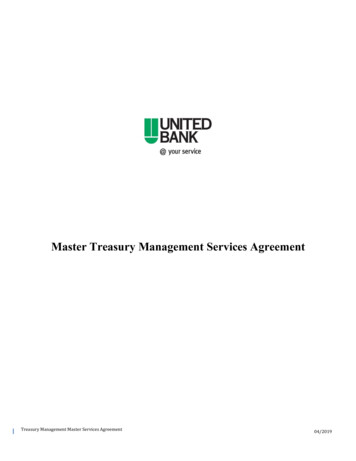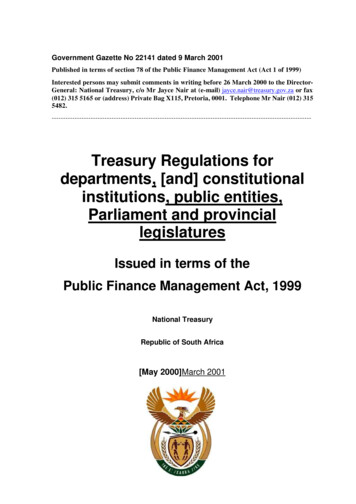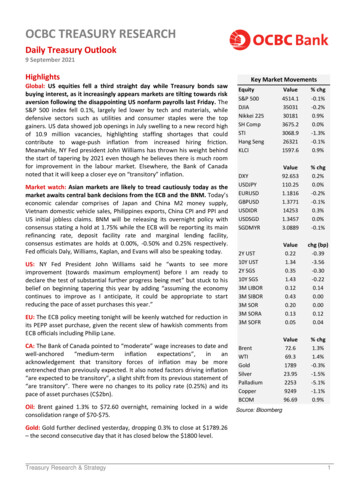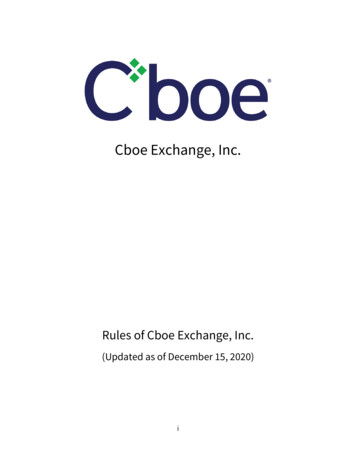
Transcription
Treasury ManagementPolicy (including Investment andLiability Policies)Adopted: 18 September 2020
Central Hawke’s Bay District CouncilTreasury Management PolicyContentsPURPOSE OF THIS POLICY .3SCOPE AND OBJECTIVES OF THIS POLICY .4Scope.4Treasury Management Objectives.4GOVERNANCE AND MANAGEMENT RESPONIBILITIES .6Overview of Management Structure .6Council .6Finance and Infrastructure Committee .6Risk and Assurance Committee .6Chief Executive Officer (CE) .7Chief Financial Officer (CFO) and Finance Team .7Delegation of authority and authority limits .7LIABILITY MANAGEMENT POLICY .8Introduction .8Borrowing limits .8Asset management plans.8Borrowing mechanisms .9Security .9Debt repayment .9Guarantees/contingent liabilities and other financial arrangements .10Internal borrowing of special funds.10New Zealand Local Government Funding Agency (LGFA) Limited .10INVESTMENT POLICY .11Introduction .11Policy .11Mix of investments .11Equity investments .11New Zealand Local Government Funding Agency Limited .12Property investments .12Financial investments .13Procurement PolicyADOPTED: TBC1
Central Hawke’s Bay District CouncilInvestment management and reporting procedures .13RISK RECOGNITION / IDENTFICATION MANAGEMENT .14Interest rate risk on external borrowing .14Approved financial instruments .15Liquidity risk/funding risk .16Counterparty credit risk .17Foreign currency .17Emissions Trading Scheme (ETS).18Operational risk .18Legal risk .18MEASURING TREASURY PERFORMANCE .19CASH MANAGEMENT .20REPORTING .21Treasury reporting .21Accounting treatment of financial instruments .21POLICY REVIEW .22APPENDIX 1: Glossary of Terms .23Procurement PolicyADOPTED: TBC2
Central Hawke’s Bay District CouncilPURPOSE OF THIS POLICYThe purpose of the Treasury Management Policy (“Policy”) is to outline approved policies andprocedures in respect of all treasury activity to be undertaken by Central Hawke’s Bay DistrictCouncil (“Council”). The formalisation of such policies and procedures will enable treasury riskswithin Council to be prudently managed.As circumstances change, the policies and procedures outlined in this Policy will be modified toensure that treasury risks within Council continue to be well managed.It is intended that the Policy be distributed to all personnel involved in any aspect of the Council’sfinancial management. In this respect, all staff must be completely familiar with their responsibilitiesunder the Policy at all times.Procurement PolicyADOPTED: TBC3
Central Hawke’s Bay District CouncilSCOPE AND OBJECTIVES OF THIS POLICYScope This document identifies the Policy of Council in respect of treasury management activities,incorporating both borrowing and investment activity.The Policy has not been prepared to cover other aspects of Council’s operations, particularlytransactional banking management, systems of internal control and financial management.Other policies and procedures of Council cover these matters.Treasury Management ObjectivesThe objective of this Policy is to control and manage costs, investment returns and risks associatedwith treasury management activities, incorporating both borrowing and investment activity.Statutory objectives All external borrowing, investments and incidental financial arrangements (e.g. use ofinterest rate hedging financial instruments) will meet requirements of the Local GovernmentAct 2002 and incorporate the Liability Management Policy and Investment Policy.Council is governed by the following relevant legislation:Local Government Act 2002, in particular Part 6 including sections 101,102, 104, 105 and113.Local Government (Financial Reporting and Prudence) Regulations 2014, in particularSchedule 4.Trustee Act 1956. When acting as a trustee or investing money on behalf of others, theTrustee Act highlights that trustees have a duty to invest prudently and that they shallexercise care, diligence and skill that a prudent person of business would exercise inmanaging the affairs of others.Council will not transact with any Council Controlled Trading Organisation (CCTO) on termsmore favourable than those achievable by Council itself, without charging any rate or ratesrevenue as security.A resolution of Council is not required for hire purchase, credit or deferred purchase ofgoods if:The period of indebtedness is less than 91 days (including rollovers); orThe goods or services are obtained in the ordinary course of operations on normal terms foramounts not exceeding in aggregate, 5.0% of the Council’s consolidated annual operatingbudget for the year (as determined by Council’s Significance and Engagement Policy).General objectives Ensure that all statutory requirements of a financial nature are adhered to.Minimise Council’s costs and risks in the management of its external borrowings.Minimise Council’s exposure to adverse interest rate movements.Arrange and structure external long term funding for Council at a favourable margin and costfrom debt lenders. Optimise flexibility and spread of debt maturity terms within the fundingrisk limits established by this Policy statement.Maintain appropriate liquidity levels and manage cash flows within Council to meet knownand reasonable unforeseen funding requirements.Manage investments to optimise returns in the long term whilst balancing risk and returnconsiderations.Procurement PolicyADOPTED: TBC4
Central Hawke’s Bay District Council Develop and maintain relationships with financial institutions, brokers and LGFA.Comply, monitor and report on borrowing covenants and ratios under the obligations ofCouncil’s lending/security arrangements.To minimise exposure to credit risk by dealing with and investing in credit worthycounterparties.Borrow funds, invest and transact risk management instruments within an environment ofcontrol and compliance.Monitor, evaluate and report on treasury performance.Ensure the Council, management and relevant staff are kept abreast of the latest treasuryproducts, methodologies, and accounting treatments through training and in-housepresentations.Ensure adequate internal controls exist to protect Council’s financial assets and to preventunauthorised transactions.In meeting the above objectives Council is, above all, a risk averse entity and does not seek risk in itstreasury activities. Interest rate risk, liquidity risk, funding risk, investment risk or credit risk, andoperational risks are all risks which Council seeks to manage, not capitalise on. Accordingly activitywhich may be construed as speculative in nature is expressly forbidden.Policy setting and managementCouncil approves Policy parameters in relation to its treasury activities. The CE has overall financialmanagement responsibility for the Council’s borrowing and investments, and related activities.The Council exercises ongoing governance over its subsidiary companies (CCO/CCTO), through theprocess of approving the Constitutions, Statements of Intent, and the appointment ofDirectors/Trustees of these organisations.Procurement PolicyADOPTED: TBC5
Central Hawke’s Bay District CouncilGOVERNANCE AND MANAGEMENT RESPONIBILITIESOverview of Management StructureThe following diagram illustrates those individuals and bodies who have treasury responsibilities.Authority levels, reporting lines and treasury duties and responsibilities are outlined in the followingsection:CouncilRisk and AssuranceCommitteeChief ExecutiveFinance andInfrastructureCommitteeChief Financial OfficerFinance TeamCouncilThe Council has ultimate responsibility for ensuring that there is an effective Policy for themanagement of its risks. In this respect the Council decides the level and nature of risks that areacceptable, given Council’s statutory objectives.The Council is responsible for approving the Policy. While the Policy can be reviewed and changesrecommended by other persons, the authority to make or change Policy cannot be delegated.In this respect, the Council has responsibility for: Approving the long-term financial position of Council through the Long Term Plan (LTP) andFinancial Strategy along with the adopted Annual Plan.Approve and adopt the Liability Management and Investment Policies (the TreasuryManagement Policy).Approval for one-off transactions falling outside Policy.Finance and Infrastructure CommitteeUnder delegation from Council: Monitor and review treasury activity through at least six monthly reporting, supplementedby exception reporting.Risk and Assurance CommitteeUnder delegation from Council: Review formally, on a three yearly basis, the Treasury Management Policy document.Evaluate and recommend amendments to the Treasury Management Policy to Council.Procurement PolicyADOPTED: TBC6
Central Hawke’s Bay District CouncilChief Executive Officer (CE)While the Council has final responsibility for the Policy governing the management of treasury risks,it delegates overall responsibility for the day-to-day management of such risks to the CE. The CE hasapproval and monitoring responsibilities over the treasury function.Chief Financial Officer (CFO) and Finance TeamThe CFO along with the Finance Team share the treasury tasks and responsibilities of the treasuryfunction ensuring an adequate segregation of treasury duties and cross-checking of treasury activity.Oversight is maintained by the CE through regular reporting and approval delegations.Delegation of authority and authority limitsTreasury transactions entered into without the proper authority are difficult to cancel given the legaldoctrine of “apparent authority”. Also, insufficient authorities for a given bank account or facilitymay prevent the execution of certain transactions (or at least cause unnecessary delays).To prevent these types of situations, Council’s Delegations Register must be complied with at alltimes.Procurement PolicyADOPTED: TBC7
Central Hawke’s Bay District CouncilLIABILITY MANAGEMENT POLICYIntroductionCouncil’s liabilities comprise of borrowings and various other liabilities. Council maintains externalborrowings in order to: Raise specific debt associated with projects and capital expenditures.Raise finance leases for fixed asset purchases.Fund the balance sheet as a whole, including working capital requirements.Fund assets whose useful lives extend over several generations of ratepayers.Borrowing provides a basis to achieve inter-generational equity by aligning long-term assets withlong-term funding sources, and ensure that the cost are met by those ratepayers benefiting from theinvestment.Borrowing limitsDebt will be managed within the following limits:ItemNet External Debt / Total RevenueNet Interest on External Debt / Total RevenueNet Interest on External Debt / Annual RatesIncomeNet Debt / Council EquityExternal, term debt committed bank facilities unencumbered cash/cash equivalents to existingexternal debt. Council Limit 150% 10% 20%LGFA Limit 175% 20% 25% 10% 115% 110%Total Revenue is defined as cash earnings from rates, government capital grants andsubsidies, user charges, interest, dividends, financial and other revenue and excludes nongovernment capital contributions (e.g. developer contributions and vested assets).Net external debt is defined as total external debt less unencumbered cash/cashequivalents.The liquidity ratio is defined as external debt plus committed LGFA/bank facilities, plusunencumbered cash/cash equivalents divided by external debt.Net interest on external debt is defined as the amount equal to all interest and financingcosts (on external debt) less interest income for the relevant period.Annual Rates Income is defined as the amount equal to the total revenue from any fundingmechanism authorised by the Local Government (Rating) Act 2002 (including volumetricwater charges levied) together with any revenue received from other local authorities forservices provided (and for which the other local authorities rate).Disaster recovery requirements, urgent financing of emergency-related works and servicesare to be met through the special funds and liquidity policy.Asset management plansIn approving new debt Council considers the impact on its external borrowing limits as well as theeconomic life of the asset that is being funded and its overall consistency with Council’s LTP andFinancial Strategy.Procurement PolicyADOPTED: TBC8
Central Hawke’s Bay District CouncilBorrowing mechanismsCouncil is able to externally borrow through a variety of market mechanisms including issuingstock/bonds, commercial paper (CP), direct bank borrowing, accessing the short and long-termwholesale debt capital markets either directly or through the LGFA, or internal borrowing of reserveand special funds. In evaluating strategies for new borrowing (in relation to source, term, size andpricing) the following is taken into account: The size and the economic life of the project.Available terms from banks, the LGFA and debt capital markets.Council’s overall debt maturity profile, to ensure concentration of debt is avoided atreissue/rollover time.Prevailing interest rates and margins relative to term for debt issuance, the LGFA, debtcapital markets and bank borrowing.The market’s outlook on future interest rate movements as well as its own.Legal documentation and financial covenants considerations.Alternative funding mechanisms such as leasing should be evaluated with financial analysisin conjunction with traditional on-balance sheet funding. The evaluation should take intoconsideration, ownership, redemption value and effective cost of funds.Council’s ability to readily attract cost effective borrowing is largely driven by its ability to rate,maintain a strong financial standing and manage its relationships with the LGFA, and financialinstitutions/brokers.SecurityCouncil’s external borrowings and interest rate management instruments will generally be securedby way of a charge over rates and rates revenue offered through a Debenture Trust Deed. Under aDebenture Trust Deed, Council’s borrowing is secured by a floating charge over all Council rateslevied under the Local Government Rating Act. The security offered by Council ranks equally or paripassu with other lenders.From time to time, and with Council approval (or through an approved person as per the delegationsregister), security may be offered by providing a charge over one or more of Councils assets, whereit is beneficial and cost effective to do so. Any internal borrowing will be on an unsecured basis.Any pledging of physical assets must comply with the terms and conditions contained withinthe Debenture Trust Deed.Debt repaymentThe funds from all asset sales, operating surpluses, grants and subsidies will be applied to specificprojects or the reduction of debt and/or a reduction in borrowing requirements, unless the Councilspecifically directs that the funds will be put to another use.Debt will be repaid as it falls due in accordance with the applicable borrowing arrangement. Subjectto the appropriate approval and policy limits, a loan may be rolled over or re-negotiated as andwhen appropriate.Council will manage debt on a portfolio basis and will only externally borrow when it is commerciallyprudent to do so.Procurement PolicyADOPTED: TBC9
Central Hawke’s Bay District CouncilGuarantees/contingent liabilities and other financial arrangementsCouncil may act as guarantor to financial institutions on loans or enter into incidental arrangementsfor organisations, clubs, trusts, Council-controlled trading organisations or Business Units, when thepurposes of the loan are in line with Council’s strategic objectives.Council will ensure that sufficient funds or lines of credit exist to meet amounts guaranteed.Guarantees given will not exceed any amount agreed by Council in aggregate. The Finance Teammonitors guarantees and reports six-monthly to the CE.Internal borrowing of special fundsSpecial Funds must generally be used for the purposes for which they have been set aside. Councilmay, however, modify such purposes from time to time. Funds held in excess of the special fundsrequirement are held as ratepayers equity reserves, and can be utilised as needed. Recorded specialfund balances must be used for their intended purpose.Council maintains its funds in short term maturities emphasising counterparty credit worthiness andliquidity. The interest rate yield achieved on the funds therefore is a secondary objectiveAny internal borrowing of equity reserves must be reimbursed for interest revenue lost.The cost of internal borrowing is set by the Finance Team from time to time.For reasons of cost distribution, records on internal borrowings will be maintained to ensure Fundsare not disadvantaged.New Zealand Local Government Funding Agency (LGFA) LimitedDespite anything earlier in this Policy, Council may borrow from the New Zealand Local GovernmentFunding Agency Limited (LGFA) and, in connection with that borrowing, may enter into the followingrelated transactions to the extent it considers necessary or desirable: Contribute a portion of its borrowing back to the LGFA as an equity contribution to the LGFA.For example borrower notes.Provide guarantees of the indebtedness of other local authorities to the LGFA and of theindebtedness of the LGFA itself.Commit to contributing additional equity (or subordinated debt) to the LGFA if required.Secure its borrowing from the LGFA and the performance of other obligations to the LGFA orits creditors with a charge over the Council's rates and rates revenue.Subscribe for shares and uncalled capital in the LGFA.Procurement PolicyADOPTED: TBC10
Central Hawke’s Bay District CouncilINVESTMENT POLICYIntroductionCouncil generally holds investments for strategic reasons where there is some community, social,physical or economic benefit accruing from the investment activity. Generating a commercial returnon strategic investments is considered a secondary objective. Investments and associated risks aremonitored and managed, and reported at least six-monthly to the Finance and Services Committee.Specific purposes for maintaining investments include: For strategic and intergenerational purposes consistent with Council’s LTP and AP.The retention of vested land.Holding short term investments for working capital and liquidity requirements.Holding assets (such as property and land parcels) for commercial returns.Provide ready cash in the event of a natural disaster. The use of which is intended to bridgethe gap between the disaster and the reinstatement of normal income streams and assets.Invest amounts allocated to specific reserves.Invest funds allocated for approved future expenditure.Invest proceeds from the sale of assets.Council recognises that as a responsible public authority all investments held, should be low risk,giving preference to conservative investment policies and avoiding speculative investments. Councilalso recognises that low risk investments generally mean lower returns.To minimise raising external debt, Council can internally borrow from equity, reserves andinvestment funds, in the first instance to meet operational and capital spending requirements.PolicyCouncil’s general Policy on investments is that: Council may hold financial, property, and equity investments if there are strategic,commercial, and economic or other valid reasons.Council will keep under review its approach to all investments and the credit rating ofapproved creditworthy counterparties.Mix of investmentsCouncil maintains investments in the following assets: Equity investmentsProperty investmentsFinancial investmentsEquity investmentsIt may be appropriate to have limited investment(s) in equity (shares) when Council wishes to investfor strategic, economic development or social reasons.Council will approve equity investments on a case-by-case basis, if and when they arise.Generally such investments will be (but not limited to) Council Controlled Trading Organisations(CCTO) or Council Controlled Organisations (CCO) to further district or regional economicdevelopment. Council does not invest in offshore entities.Procurement PolicyADOPTED: TBC11
Central Hawke’s Bay District CouncilCouncil reviews performance of these investments as part of the annual planning process to ensurethat stated objectives are being achieved.Any disposition of these investments requires approval by Council. Acquisition of new equityinvestments requires Council approval. The proceeds from the disposition of equity investments willbe taken to the Capital Projects Fund. .All income, including dividends, from Council’s equity investments is included in general revenue.Equity investment performance is reported to the Finance and Services Committee at least annually,along with the consideration of and approval of the Statement of Intent.New Zealand Local Government Funding Agency LimitedDespite anything earlier in this Policy, Council may invest in shares and other financial instruments ofthe New Zealand Local Government Funding Agency Limited (LGFA), and may borrow to fund thatinvestment.Council's objective in making any such investment will be to: Obtain a return on the investment.Ensure that the LGFA has sufficient capital to remain viable, meaning that it continues as asource of debt funding for the Council.As a borrower, Council’s LGFA investment includes borrower notes.Property investmentsCouncil’s primary reason to own propertyis to allow it to achieve its strategic objectives as stated inthe LTP or deemed to be a core Council function. Council reviews property ownership throughassessing the benefits of continued ownership in comparison to other arrangements which coulddeliver the same results. This assessment is based on the most financially viable method of achievingthe delivery of Council services. Council generally follows similar assessment criteria in relation tonew property investments.Council may also hold investment properties that are not held for core function delivery purposes,where such a property is held for commercial returns (both rental returns and capital gains). Anypurchase of investment properties must be approved by Council Resolution.Council reviews the performance of its property investments at least annually and ensures that thebenefits of continued ownership are consistent with its stated objectives. Council’s policy is todispose of any property that does not achieve a commercial return having regard to any restrictionson title or other requirements or needs to achieve Council objectives. All income, including rentalsand ground rent from property investments is included in the consolidated revenue account. Allrented or leased properties will be at an acceptable commercial rate of return so as to minimise therating input, except where Council has identified a level of subsidy that is appropriate.Proceeds from the disposition of property investments are used firstly in the retirement of relateddebt and then are credited to the Capital Projects Fund.Council’s investment in properties, other than reserves and those required for own occupation/coreservice delivery and infrastructural services, will not exceed 50% of total fixed assets in the land andbuilding category.Procurement PolicyADOPTED: TBC12
Central Hawke’s Bay District CouncilAny purchased properties must be supported by a current registered valuation, substantiated bymanagement including a fully worked capital expenditure analysis.Financial investmentsObjectivesCouncil’s primary objectives when investing is the protection of its investment capital. Accordingly,Council may only invest in approved creditworthy counterparties. For financial investments(excluding equity and property investments) Council should only hold investments with a underlyingcredit rating of AA- or above.Credit ratings are monitored and reported at least six-monthly.Council’s investment portfolio will be arranged to provide sufficient funds for planned expendituresand allow for the payment of obligations as they fall due. Council prudently manages liquid financialinvestments as follows: Any liquid investments must be restricted to a term that meets future cash flow and capitalexpenditure projections.Council may choose to hold specific reserves in cash and financial investments. Interestincome relating to special reserves is allocated to those accounts annually based on theopening balance.Internal borrowing will be used wherever possible to minimise external borrowing.Trust fundsWhere Council hold funds as a trustee, or manages funds for a Trust then such funds must beinvested on the terms provided within the Trust Deed. If the Trust’s Investment Policy is notspecified then this Policy should apply.Investment management and reporting proceduresCouncil’s policy for the management and reporting of investments i
Treasury Management Objectives The objective of this Policy is to control and manage costs, investment returns and risks associated with treasury management activities, incorporating both borrowing and investment activity. Statutory objectives All external borrowing, investments and incidental financial arrangements (e.g. use of
